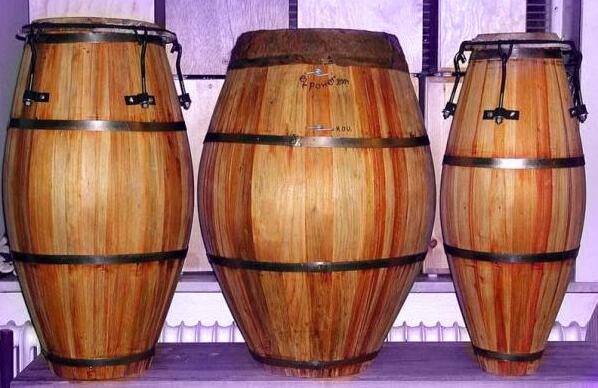Candombe drums on:
[Wikipedia]
[Google]
[Amazon]
 The tambores de candombe or tamboriles are drums used in the playing of
The tambores de candombe or tamboriles are drums used in the playing of
chico (small, high timbre, marks the tempo)
repique (medium, syncopation and improvisation)
piano (large, low timbre, melody).
An even larger drum, called ''bajo'' or ''bombo'' (very large, very low timbre, accent on the fourth beat), was once common but is now declining in use.
A ''cuerda'' at a minimum needs three drummers, one on each part. A full cuerda will have 50-100 drummers, commonly with rows of seven or five drummers, mixing the three types of drums. A typical row of five can be piano-chico-repique-chico-piano, with the row behind having repique-chico-piano-chico-repique and so on to the last row. Tamboriles are made of wood with animal skins that are rope-tuned or fire-tuned minutes before the performance. They are worn at the waist with the aid of a shoulder strap called a ''talig or talí'' and played with one stick and one hand. A key rhythmic figure in ''candombe'' is the clave (in 3-2 form). It is played on the side of the drum, a procedure known as "''hacer madera''" (literally, "making wood").
YouTube video - Candombe music
Membranophones Uruguayan musical instruments
 The tambores de candombe or tamboriles are drums used in the playing of
The tambores de candombe or tamboriles are drums used in the playing of Candombe
''Candombe'' is a style of music and dance that originated in Uruguay among the descendants of liberated African slaves. In 2009, the United Nations Educational, Scientific and Cultural Organization (UNESCO) inscribed ''candombe'' in its Repres ...
music of Uruguay
Uruguay (; ), officially the Oriental Republic of Uruguay ( es, República Oriental del Uruguay), is a country in South America. It shares borders with Argentina to its west and southwest and Brazil to its north and northeast; while bordering ...
. They are single skin headed and there are three sizes: piano (bass range), repique (tenor range), and the chico (alto range). The drums are made of wood and have a curved barrel shape with its base very narrow.
Music and description
''Candombe'' is performed by a group of drummers called a cuerda. The barrel-shaped drums, or tamboriles, have specific names according to their size and function:chico (small, high timbre, marks the tempo)
repique (medium, syncopation and improvisation)
piano (large, low timbre, melody).
An even larger drum, called ''bajo'' or ''bombo'' (very large, very low timbre, accent on the fourth beat), was once common but is now declining in use.
A ''cuerda'' at a minimum needs three drummers, one on each part. A full cuerda will have 50-100 drummers, commonly with rows of seven or five drummers, mixing the three types of drums. A typical row of five can be piano-chico-repique-chico-piano, with the row behind having repique-chico-piano-chico-repique and so on to the last row. Tamboriles are made of wood with animal skins that are rope-tuned or fire-tuned minutes before the performance. They are worn at the waist with the aid of a shoulder strap called a ''talig or talí'' and played with one stick and one hand. A key rhythmic figure in ''candombe'' is the clave (in 3-2 form). It is played on the side of the drum, a procedure known as "''hacer madera''" (literally, "making wood").
Master Candombe drummers
Among the most important and traditional Montevidean rhythms are: Cuareim, Ansina y Cordon. There are several master drummers who have kept Candombe alive uninterrupted for two hundred years. Some of highlights are: in Ansina school: Wáshington Ocampo, Héctor Suárez, Pedro "Perico" Gularte, Eduardo "Cacho" Giménez, Julio Giménez, Raúl "Pocho" Magariños, Rubén Quirós, Alfredo Ferreira, "Tito" Gradín, Raúl "Maga" Magariños, Luis "Mocambo" Quirós, Fernando "Hurón" Silva, Eduardo "Malumba" Gimenez,Alvaro Salas
Alvaro Salas (born May 25, 1953 in Montevideo, Uruguay) is a Uruguayan Master Candombe drummer and percussion teacher.
Early life
Salas was born in Ansina, a neighbourhood in Palermo, Montevideo.
Career in music industry
Salas has worked, bot ...
, Daniel Gradín, Sergio Ortuño y José Luis Giménez.
References
* {{cite book , first=John , last=Beck , title = Encyclopedia of Percussion , year = 1994 , publisher = Garland , isbn = 978-0-8240-4788-7External links
YouTube video - Candombe music
Membranophones Uruguayan musical instruments